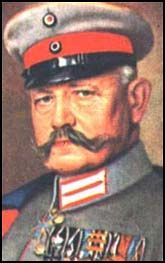Paul von Hindenburg
 |
Paul von Hindenburg was born in 1847 and died in 1934. He was Weimar Germany’s second president, after Ebert, and he led the nation through the catastrophe of the Wall Street Crash. Hindenburg dismissed the last hope Weimar really had – Heinrich Brüning – and he appointed Hitler chancellor on January 30th 1933, as the constitution allowed him to do.
Hindenburg joined the Prussian Cadet Corps in 1858. In 1866 he was commissioned into a guards regiment and he fought in both the Seven Weeks War against Austria and the Franco-Prussian War. He was decorated for bravery. In January 1871, he represented his regiment at the declaration of the German Empire.
In 1911, he retired from active military service as head of the Fourth Army Corps. In August 1914, he was re-called to military service to lead the Eighth Army in Prussia. By mid-September 1914, he had achieved national fame by inflicting two severe defeats on the Russian Army at Tannenburg and the Masurian Lakes. Hindenburg became a national hero in Germany. He was promoted to Field Marshall and given the sole command of the Eastern Front in November 1914.
In August 1916, Hindenburg was appointed Chief of the Greater German General Staff. This position gave him vast power even in the civil sphere. Hindenburg had a major input into the harsh Treaty of Brest-Litovsk with Russia. It was Hindenburg who advised the government to seek an armistice as he knew that by the autumn of 1918, Germany could not successfully fight against the Allies – especially as they were now fighting the full might of the American army. The March 1918 German offensive on the Western Front had failed and Germany had to save what she could, especially the fact that Germany itself had not suffered the material damage that France and Belgium had suffered. This would not be true if the Allies actually got to Germany and the war was continuing.
Hindenburg also used his huge influence to persuade Kaiser Wilhelm to abdicate and to go to Holland. Hindenburg remained in control of the German army until July 1919 when he once again retired from the military.
In 1925, Hindenburg was persuaded to stand in the presidential elections – the result of Ebert’s death. With his background he was not an obvious choice as Hindenburg had no love of republics and was a monarchist at heart. However, he was persuaded that his country needed an authoritative person to build on the growth Weimar Germany experienced from 1924 on. There was still a belief amongst many people that the army had not lost the war but had been let down by back-stabbing politicians. Therefore, Hindenburg’s credentials were good. He won the 1925 presidential election (though not overwhelmingly) and was re-elected in 1931.
In 1932, Hindenburg dismissed as chancellor the one capable politician Weimar Germany had from 1930 to January 1933 – Heinrich Brüning. Such was Hindenburg’s fear of communism that the association ofBrüning’s planned economic reforms with communism was enough to prevent their introduction. It also ensured the dismissal of Brüning.
In the later years of his presidency, Hindenburg was heavily influenced by those who surrounded him – especially his son. Hindenburg showed more and more signs of senility and was open to their suggestions. Though he disliked Hitler because he did not come from the right social class and had only been a corporal in the war, he was persuaded to appoint him chancellor in January 1933. The constitution gave him the power to do this. Hindenburg had been persuaded by his son and Franz von Papen, that Hitler could be controlled and that if anything went wrong, then Hitler and the Nazis would get the blame thus damaging their political standing in Germany. Von Papen hoped that he would set the political agenda and that Hitler would simply agree to this.
In February 1933, the Reichstag building was burned down. Hitler told the ageing president that it was the work of the communists in Germany and that he, as president, should introduce emergency powers which Hitler would loyally carry out. Hindenburg readily agreed. Hitler also knew how to play on the president’s fear of communism. The introduction of emergency powers – lawful under the constitution – was the start of Hitler’s move to a dictatorship.
Hindenburg died at his Prussian estate in August 1934. Hitler used the opportunity to give him a state funeral. He then dropped the title president and adopted the title most associated with him – Fuhrer. Hindenburg was buried at Tannenburg.
The Weimar Constitution was remarkably democratic and, on paper, offered Germany a great deal. However, it was open to misuse and with the amount of power it gave to a president, posed Weimar Germany many problems once that president in power was open to so much external influence.
Related Posts
- Field Marshall Paul von Hindenburg was Germany's most famous army commander in World War One. Hindenburg found fame in the war with victories against the…
- Adolf Hitler led Germany throughout World War Two. His desire to create an aryan race was paramount in his ethos and political campaigns. Hitler had no…
